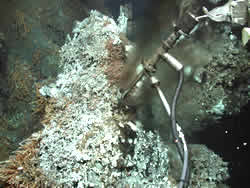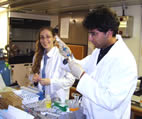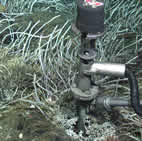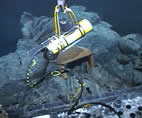
 |
| |
||||||||
|
|||||||||||||||||||||||||||||||||||||||||||||||||||||||||||||
 The ' Beast' working at Endeavour site. (click image for larger view) |
Hi, my name is Sanjoy, I am a graduate student in Earth and Space Sciences and Astrobiology at the University of Washington in Seattle. My job onboard the Atlantis involves microbiology, which is the study of single-cell life forms (like bacteria) too small to see with the naked eye.
To study the microbiology of hydrothermal systems, I depend on Dr. Butterfield’s hot fluid sampler (“The Beast” as it is known to us). This device allows the sampling of vent fluid that can then be analyzed in the labs onboard the ship. For microbiology, I don’t use the water coming directly from the “black smokers”, since that water is often way too hot for life to exist in. Indeed, the water coming from those smokers is usually above 150 degrees C (we measured one vent that had water temperature above 300 degrees C!). Instead, I use water that comes from diffuse vents, which are located on the flanks of the black smokers. The reason I use those is that the water is generally a lot cooler (less than 80 degrees C), so the probability of sampling microbes that are alive is much higher.
In the lab, I have tubes in which I put different substances that allow me to try to grow cultures of specific microbes. So when I get the vent water from Dr. Butterfield, I inject a little amount into different tubes. I proceed to put those tubes in hot ovens (my hottest oven is at 90 degrees C), and I see if the microbes like it. If they do, they will multiply to such an extent that I can see their presence. This has happened to me several times since the cruise started.
Those microbes represent the communities that live down below the ocean floor, which thrive because of the heat and the different chemicals that are dissolved in the hot water. Microbes are neat in that those at the vents, unlike us, don’t need oxygen to breathe. So far in this cruise, I have cultured microbes that breathe iron! “Breathe” shouldn’t be taken literally of course, since they are obviously too small to have lungs. They use iron in their metabolic processes, which is a fancy way to say that they use iron in clever chemical reactions from which they can extract the energy they need to survive.
But why bother studying microbes that come from the sea-floor, who cares? Their study is justified for several reasons. First, it is interesting, and that’s almost a reason enough, but what is really cool is that since they live in “extreme environments” (under high pressure and temperature), they essentially tell us under which range of conditions life is feasible. The reason I put “extreme environments” in quotes is that it’s only extreme from a human point of view. Most of the environments on Earth are “extreme”. Think about it, the temperature between which you are too cold versus too hot is quite small compared to the range of temperatures that exist on our planet. Life on Earth is found in conditions ranging from the coldest arctic ice, to the extremely hot hydrothermal systems of the ocean floor. Microbes are also found in very acidic conditions, very salty conditions, and very alkaline conditions. Such microbes are often called “extremophiles” (lovers of extremes). While conditions on the surface of the Earth where humans are happy are likely to be extremely rare outside of our home planet, the range of conditions in which microbes are found on Earth are more likely to be found on other planets and moons. For example, Jupiter’s moon Europa is completely covered by ice, but there is enough tidal energy given by Jupiter (because Jupiter is so big), that under the ice-sheet most likely exists a global ocean that could be 10 times as deep as what we find on Earth! And what could exist at the bottom of this putative ocean? That’s right, hydrothermal vents! Another example is that there are microbes found in hydrothermal systems called methanogens, meaning they produce a gas called methane. The majority of the methane in Earth’s atmosphere comes from biology, and methane has been discovered in the atmosphere of Mars! Although non-biological processes that produce methane do exist, as of today, we cannot distinguish the martian methane as being biological in origin or not, so the mystery remains (an instrument called a mass spectrometer on the surface of Mars would allow scientists to answer this question, but that’s another story). The point that I want to make is that understanding extreme life on Earth might help us identify environments on other moons and planets where life could exist.
Studying “extreme life” can also help us understand how life began on Earth. The Earth is 4.5 billion years old, and the earliest record of life goes back as far as 3.7 billion years ago. Our planet was very different in those days. There were no plants, no soil, no animals, no oxygen, no big mountains, and the sky was likely not blue. It was period in geological time called the Archean. During the early Archean, Earth was bombarded with big asteroids (a huge one the size of Mars collided with a young Earth 4.5 billion years ago. This impact resulted in the creation of the moon). These large impacts likely continued up to at least 3.8 billion years ago. Remember that I told you that Earth did not have oxygen; this means that the planet had no ozone layer to protect the surface from harmful UV radiation. In essence, this means that the surface was UV sterilized (much like Mars today). As such, the only haven was in the ocean (water absorbs UV), but when asteroids bigger than 440 km across hit the ocean, they had so much energy that the entire ocean evaporated! This likely killed all life in the ocean as well, so where could life still survive? In the protective crust under hydrothermal vents! This means that studying life from hydrothermal vents today could possibly be a window to the Earth’s past. Pretty cool!
I really enjoy working on board the Atlantis, since we are all studying the vents from a different perspective. At the end, we will have a better understanding regarding the complexity of hydrothermal systems. Furthermore, everyone is really excited about what they do, it’s easy to get satisfying explanations about the other instruments people use, and as such, I get excited even when its not my data that comes on board.
|
Cruise Calendar
| ||||||
|
August 2007
| ||||||
| S | M | T | W | T | F | S |
| 1 | 2 | 3 | 4 | |||
| 5 | 6 | 7 | 9 | 10 | 11 | |
| 12 | 13 | 14 | 15 | 16 | 17 | 18 |
| 19 | 20 | |||||
Today's Events:
AUV dive #2 completed
Gravity core.
Begin JASON dive
J2-289 (48 hour pressure dive)
|
Today's
photos |
|
click
caption for larger view |
 Sanjoy Som and Annie Bourbonnais working in the laboratory at sea. |
 Diffuse flow sample with the 'Beast'. |
 Placing pressure instrument on Magnesia benchmark. Placing pressure instrument on Magnesia benchmark. |
| NeMO Home |About NeMO | Expeditions | NeMO Net | Explore | Dive! | Education |